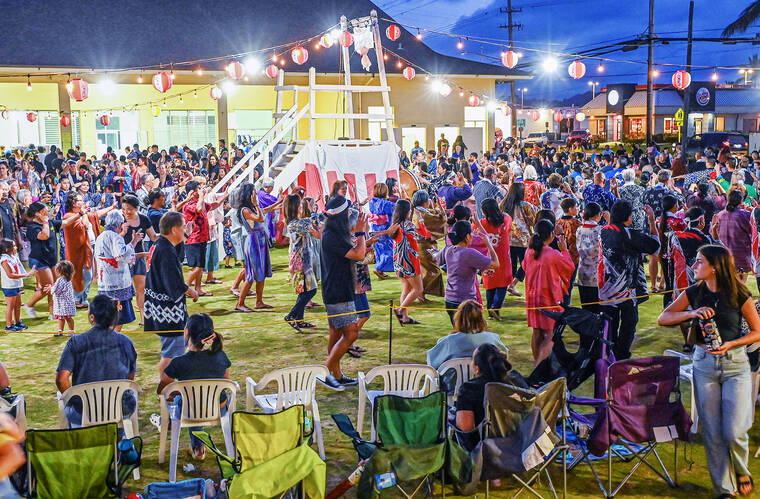KAPA‘A — The leadership at the Kapa‘a Hongwanji Mission anticipated the large turnout of people to its bon dance held over the weekend at the temple located along Kuhio Highway, where traffic was slowed by many motorists that were curious about the lights and sounds.
“People just want something to do,” said retired judge Trudy Senda, who was helping prepare batches of pronto pups, yakitori chicken and beef on a stick, and flying saucers. “This is the first bon dance in three years, and people just want to get out and do something.”
The Kapa‘a Hongwanji Mission bon dance is the first scheduled event on the Kaua‘i Buddhist Council’s calendar of bon dances following the group’s decision to allow the temples to resume bon activities after the COVID-19 pandemic.
Obon is based in Buddhism. It is a time to commemorate and celebrate an individual’s ancestors, whose spirits are believed to temporarily return to this world to visit their relatives.
These roots arrived in Hawai‘i with the first immigrants from Japan, who were brought over to work in the plantations. Obon grew outside the plantation camps, as other ethnic groups assimilated the event into a uniquely popular Hawai‘i community event. One of the changes was the name change of obon to a more vernacular “bon.”
Gerald Hirata, of the Kaua‘i Soto Zen Temple in Hanapepe, invites people to their bon dance on Friday and Saturday, where the Soto Zen bon dances have a constantly-evolving exhibit of the early days of plantation life and lifestyles, including the bon dance.
Rev. Takaaki Tanabe, of the Jodo Mission of Hawai‘i, in charge of the Jodo Mission in Kapa‘a and Koloa, started his obon work by helping Bishop Kosen Ishikawa with the second Timbers Resort Kaua‘i lantern floating last week. The event represents the sendoff of ancestral spirits following their visits to this world — it is known as toro nagashi.
“No bon for Jodo temples, this year,” said Rev. Tanabe in taking his turn at flipping special cooking screens for the yakitori. “That means I can help, anywhere.”
Among the scores of volunteers preparing the bon dance food, a small group from the Hanalei Nihonjin Kai Japanese Cemetery worked away from the crowd preparing special taro agemono.
The prep work was being done as part of a fundraiser to restore the cemetery containing approximately 208 known interments. The interments were demolished during a landslide on April 15, 2018, when a record nearly 50 inches of rain fell in a 24-hour period in the North Shore area.
The cemetery is private and located on private land with the Cemetery Board of the State of Hawai‘i approving the application for “license as a Cemetery Authority” to landowner Harold Kobayashi in 1969, states a historical document prepared by the Hanalei Nihonjin Kai.
The earliest surving documents for the Hanalei Nihonjin Kai go back to 1958 for a meeting that was called to order by Megumi Asega and minutes by George Kodama.
At the site, a concrete monument greeting visitors at the entrance that, with the help of Rev. Mieko Majima of the Kapa‘a Hongwanji, was built in 1928. This was not the year of the cemetery’s first burial because, according to documents from the Hanalei Nihonjin Kai, some of the burial sites were simply marked with boulders. The group estimates the burial beginnings taking place more than 100 years ago, a headstone engraved in English having the earliest recorded death date of May 1913.
Following five years of trying to collect gravestones and artifacts of the cemetery, Hanalei Nihonjin Kai plans to erect a memorial wall commemorating the more than 200 graves with the efforts of the Friday night bon dance at Kapa‘a Hongwanji helping with that effort.









Bon dance. I went to two bon dance in my life. Of which I was invited. Never did catch on what they were doing. But this has become a local favorite. Like a carnival. But not.